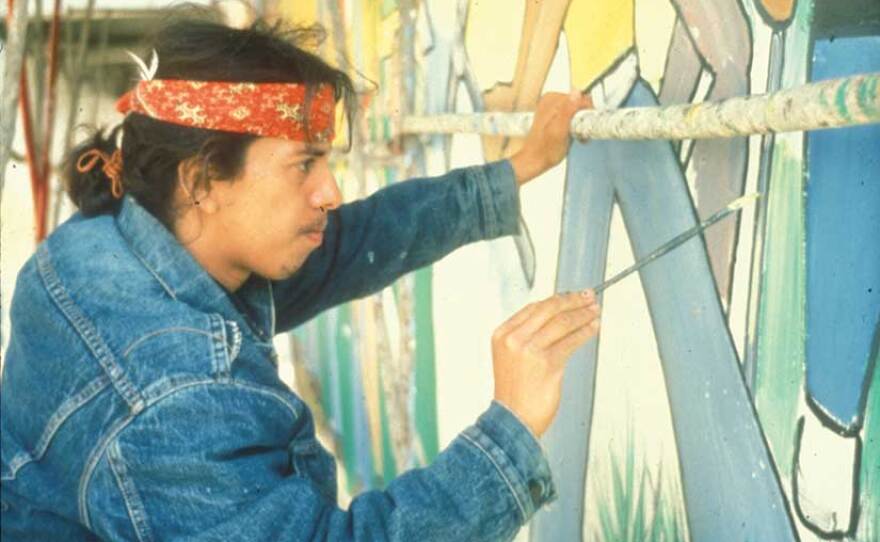In "La Tierra Mia," a new book and correlating exhibition at North Park's Swish Projects gallery, writer Bob Dominguez gathered photography and handwritten stories about Chicano Park from the past 50 years.
"I’m one of the only people in my immediate family to leave home," said Dominguez, who grew up on 32nd and Ocean View Blvd in Logan Heights, but now lives in New York. "So I always feel, honestly, a loss of connection with them at times. And then when you think broader about something like the park, I worry about a loss of connection between generations."
The book features more than a hundred pages of photography, beginning with the Chicano Park protest and takeover in April of 1970. In the introduction, he describes how a student, Mario Solis, spotted construction beginning in promised parkland, and how word spread through residents of the community. That night, more than 200 people assembled to evict the construction crews.

The title of the book and exhibit, "La Tierra Mia," has historic connections to the Chicano Park movement and fight to claim land in the Barrio Logan and Logan Heights communities.
For many in the community, the urgency of this action came layered from historical burdens — including zoning changes after WWII, the 1963 construction of Interstate 5 displacing many residents and just six years later, the support pylons for the new Coronado Bridge also cut through the neighborhood. The park was promised in 1969. "The one fleeting promise from the city," Dominguez wrote. " ... a 1.8 acre plot of land, which would be used to create a park, eventually dubbed Chicano Park by its founders. It was this same plot of land that Mario Solis stumbled upon, finding bulldozers at work."
Dominguez's first outreach was to Victor Ochoa, one of the original muralists and who recently completed a new mural in the park. From there, he studied archives in the UC San Diego library, spoke with the Chicano Park Steering Committee, and talked with as many community members, artists and their families as possible.
"A lot of these original muralists, some of them aren't here anymore, some, they're getting up in age. And they have stories. Victor Ochoa has stories for days," he said.

The book features writing from Dominguez along with handwritten letters from activists, muralists and photographers connected with Chicano Park from the last five decades, including Jess Angelica, David Aguilar, Herman Baca, Bianca Gonzalez and more.
The photography is harder to pin down to individual sources, and in many cases, Dominguez is only able to credit the donor or archive. "Same with my family ones, those have been in a shoebox for years," he said. "Even my Tia couldn’t tell me who actually shot them."
The book, arranged chronologically, concludes with work by six young photographers working today, though the aesthetics of the work feels in line with the rest of the book — each of the six shoot in film.
Dominguez, who is 31, worries the stories of the older members of the community are at risk of being forgotten, and wants to make sure the younger generations can not only understand and learn from the history of the park, but relate to it and make it part of their own stories.
In the introductory essay, he spells this out:
"I worry that a takeover of land has succumbed simply to a fleeting photo opp. I worry about past generations not being around to tell their story. I worry about outsiders coming into the neighborhood simply to reap cultural cachet. I worry the word 'barrio' is simply morphing into a branding term, with little consideration for the actual residents that make up the space. I worry kids don’t care, and they have a limited pool of older folks to put them on game."
Dominguez noted that this project is one perspective, and one collection of memories — something he kept in mind while gathering these stories and pitching the project to the Chicano Park Steering Committee, to which any profits will be donated.
Working as a writer in the music and arts scene in New York, he is aware the book may find an audience outside of San Diego. If so, he hopes it inspires young people to dig up the stories in similar places in their own communities. But "La Tierra Mia" is first and foremost for Chicano Park and the Chicano community here.
"For me, it's always in context of the park — that was about preserving what a Chicano is, and a Chicano is a Mexican-American," Dominguez said. "And preserving that, in that regard, it's personal to me, maintaining that, because that's — I'm lineage to that too."

For the gallery exhibition, Dominguez focused on the younger generation. While the 1988 documentary will screen on loop ("It's actually pretty good," said Dominguez), the Chicano Park photography in the gallery is from the six young photographers, Fedella Lizeth, Bianca Gonzalez, Valeria Carranza, Angelica Grijalva, Arturo Cano and Joshua Sanchez. Their work makes up the final pages of the book.
Swish Projects, Dominguez noted, is a new gallery, and owner Edwin Negado champions the work of young and emerging artists.
He dedicated the book to the more than 200 individuals involved in the Chicano Park takeover in 1970. Though now, 50 years later, the exhibition shows that a big part of this project is looking to Chicano Park's future.
The "La Tierra Mia" exhibition is on display by appointment at Swish Projects in North Park at 2903 El Cajon Blvd through Nov. 8, and the book can be purchased onsite or at latierramiabook.com.







